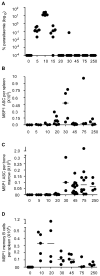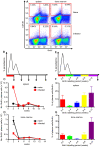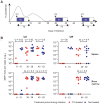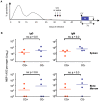Functional memory B cells and long-lived plasma cells are generated after a single Plasmodium chabaudi infection in mice
- PMID: 20011127
- PMCID: PMC2784955
- DOI: 10.1371/journal.ppat.1000690
Functional memory B cells and long-lived plasma cells are generated after a single Plasmodium chabaudi infection in mice
Abstract
Antibodies have long been shown to play a critical role in naturally acquired immunity to malaria, but it has been suggested that Plasmodium-specific antibodies in humans may not be long lived. The cellular mechanisms underlying B cell and antibody responses are difficult to study in human infections; therefore, we have investigated the kinetics, duration and characteristics of the Plasmodium-specific memory B cell response in an infection of P. chabaudi in mice. Memory B cells and plasma cells specific for the C-terminal region of Merozoite Surface Protein 1 were detectable for more than eight months following primary infection. Furthermore, a classical memory response comprised predominantly of the T-cell dependent isotypes IgG2c, IgG2b and IgG1 was elicited upon rechallenge with the homologous parasite, confirming the generation of functional memory B cells. Using cyclophosphamide treatment to discriminate between long-lived and short-lived plasma cells, we demonstrated long-lived cells secreting Plasmodium-specific IgG in both bone marrow and in spleens of infected mice. The presence of these long-lived cells was independent of the presence of chronic infection, as removal of parasites with anti-malarial drugs had no impact on their numbers. Thus, in this model of malaria, both functional Plasmodium-specific memory B cells and long-lived plasma cells can be generated, suggesting that defects in generating these cell populations may not be the reason for generating short-lived antibody responses.
Conflict of interest statement
The authors have declared that no competing interests exist.
Figures







Similar articles
-
Distinct kinetics of memory B-cell and plasma-cell responses in peripheral blood following a blood-stage Plasmodium chabaudi infection in mice.PLoS One. 2010 Nov 23;5(11):e15007. doi: 10.1371/journal.pone.0015007. PLoS One. 2010. PMID: 21124900 Free PMC article.
-
Malaria-specific antibody responses and parasite persistence after infection of mice with Plasmodium chabaudi chabaudi.Parasite Immunol. 2007 Sep;29(9):435-44. doi: 10.1111/j.1365-3024.2007.00960.x. Parasite Immunol. 2007. PMID: 17727567
-
Germinal centre and marginal zone B cells expand quickly in a second Plasmodium chabaudi malaria infection producing mature plasma cells.Parasite Immunol. 2009 Jan;31(1):20-31. doi: 10.1111/j.1365-3024.2008.01066.x. Parasite Immunol. 2009. PMID: 19121080 Free PMC article.
-
A dual role for B cells in Plasmodium chabaudi chabaudi (AS) infection?Res Immunol. 1994 Jul-Aug;145(6):412-9. doi: 10.1016/s0923-2494(94)80170-3. Res Immunol. 1994. PMID: 7899705 Review.
-
Development of B Cell Memory in Malaria.Front Immunol. 2019 Apr 2;10:559. doi: 10.3389/fimmu.2019.00559. eCollection 2019. Front Immunol. 2019. PMID: 31001244 Free PMC article. Review.
Cited by
-
Re-emergence of the apicomplexan Theileria equi in the United States: elimination of persistent infection and transmission risk.PLoS One. 2012;7(9):e44713. doi: 10.1371/journal.pone.0044713. Epub 2012 Sep 6. PLoS One. 2012. PMID: 22970295 Free PMC article.
-
Does EBV alter the pathogenesis of malaria?Parasite Immunol. 2015 Sep;37(9):433-45. doi: 10.1111/pim.12212. Parasite Immunol. 2015. PMID: 26121587 Free PMC article. Review.
-
Using two phases of the CD4 T cell response to blood-stage murine malaria to understand regulation of systemic immunity and placental pathology in Plasmodium falciparum infection.Immunol Rev. 2020 Jan;293(1):88-114. doi: 10.1111/imr.12835. Immunol Rev. 2020. PMID: 31903675 Free PMC article. Review.
-
IgM+ and IgM- memory B cells represent heterogeneous populations capable of producing class-switched antibodies and germinal center B cells upon rechallenge with P. yoelii.J Leukoc Biol. 2022 Nov;112(5):1115-1135. doi: 10.1002/JLB.4A0921-523R. Epub 2022 Jun 3. J Leukoc Biol. 2022. PMID: 35657097 Free PMC article.
-
Analysis of human B-cell responses following ChAd63-MVA MSP1 and AMA1 immunization and controlled malaria infection.Immunology. 2014 Apr;141(4):628-44. doi: 10.1111/imm.12226. Immunology. 2014. PMID: 24303947 Free PMC article. Clinical Trial.
References
-
- Cohen S, McGregor IA, Carrington S. Gamma-globulin and acquired immunity to human malaria. Nature. 1961;192:733–737. - PubMed
-
- Conway DJ, Cavanagh DR, Tanabe K, Roper C, Mikes ZS, et al. A principal target of human immunity to malaria identified by molecular population genetic and immunological analyses. Nat Med. 2000;6:689–692. - PubMed
-
- Metzger WG, Okenu DM, Cavanagh DR, Robinson JV, Bojang KA, et al. Serum IgG3 to the Plasmodium falciparum merozoite surface protein 2 is strongly associated with a reduced prospective risk of malaria. Parasite Immunol. 2003;25:307–312. - PubMed
Publication types
MeSH terms
Substances
Grants and funding
LinkOut - more resources
Full Text Sources
Other Literature Sources
Medical
Research Materials

